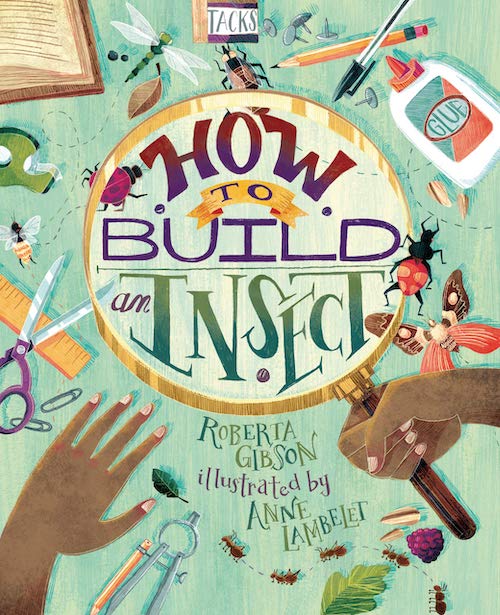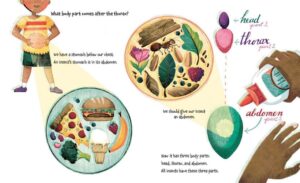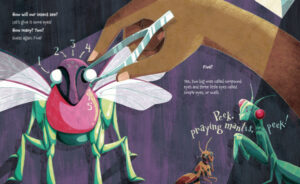
978-1541578111 | Millbrook Press
This week, I’m excited to share author Roberta Gibson‘s debut picture book, HOW TO BUILD AN INSECT, illustrated by Anne Lambelet. I met Roberta at a recent (virtual) gathering of local SCBWI PAL members in Arizona and couldn’t wait to get my hands on a copy of her book.
This clever STEAM title invites children to “build” an insect, talking readers through the various body parts in a relatable way, using questions and comparisons. (“Below our head, we have shoulders and a chest. An insect’s chest is called its thorax.”) The reading is both informative and interactive:
“How will the insect move?
Give it some legs.
How many legs?
Two like us?
Four?
Eight?”
Too many. Eight legs would make it a spider…
What about ears?
An insect can have its ears anywhere. …
on its thorax, on its abdomen, or even on its knees!”
See what I mean?? This book is brilliant! I’m so glad Roberta was kind enough to answer a few questions:
DIANNE: Hi, Roberta. Congratulations on your debut picture book!
HOW TO BUILD AN INSECT came together rather quickly after you saw an open call for K-3 nonfiction submissions on Lerner’s blog in early March 2018. The timeline started ticking and you got to work. Can you share a little of that story?
ROBERTA: Thank you for having me. I would be happy to share. When Lerner posted an open call for STEM picture book manuscripts, I knew it was a golden opportunity. However, they also wanted topics presented “in playful or unconventional ways.” None of my polished manuscripts fit and with a deadline of May 1, 2018, I had about six weeks to come up with one that did.
I wrote the first draft almost immediately. Author Dusti Bowling, who was writer-in-residence at the Tempe (AZ) Library at the time, critiqued it for me. It was good, but it lacked something, like a stew that needs that one more ingredient to take it over the top. The last bit to come together – which was comparing insect and human anatomy — happened early one morning a few days before the deadline. I keep a running notebook for each of my projects and I even wrote down the time: 4:30 a.m. on April 25, 2018. I submitted the manuscript a few days later. Whew!
DIANNE: That’s amazing! Sometimes a time crunch works in our favor!
I was really charmed by your book and wished I’d had it when I was teaching. I remember back-in-the-day doing a hands-on AIMS “build-an-insect” project with students using clay and toothpicks. This book would have been perfect to share before we began!
What was the inspiration? How did you land on this fun, call-and-response – “What else should we add? What about bones like ours? Should we give it a skeleton?” – format?
ROBERTA: I’m so glad you like the book. I’ve had kids use marshmallow and toothpicks to make model ants, but I was always afraid someone is going to eat their creations and bite into a toothpick. I’m going to have to give clay a try.
The call-and-response format came from my days doing workshops for children. As you probably know, asking questions is a way to gauge prior knowledge (cued recall) and check how engaged the students are. Having to think about a problem also makes the solution more memorable. It seemed natural to use it in the text.

CLICK TO ENLARGE © illustratrations by Anne Lambelet
DIANNE: The illustrations are fantastic. I loved the way that Anne Lambelet opens the book with a spread that is part mad scientist lab, part art studio.
Most people don’t realize that picture book authors don’t generally communicate with the illustrator, but with your entomology background, were you asked, or did you find you needed to weigh in along the way?
ROBERTA: Isn’t Anne Lambelet a fabulous illustrator? She brought such vibrancy and fun to every page. I hope one day we get to do a joint program together. Or in a perfect world, maybe work together on another book.
True, most people don’t realize that the illustrations, and even the choice of the illustrator, are totally out of the author’s hands. I’ve been saying the pairing is like a blind date. That said, our book was probably more collaborative than usual. Editorial Director Carol Hinz asked me to provide insect anatomy resources beforehand and I did check the illustrations for accuracy during editing. Questions came up that I could help with, such as how many legs does a centipede have (not exactly 100, but somewhere above 30).
 CLICK TO ENLARGE © illustratrations by Anne Lambelet
CLICK TO ENLARGE © illustratrations by Anne Lambelet
DIANNE: I noticed on your website that, in addition to picture books, you write poetry and mysteries. What projects are you working on now? Do you have any tips to share with writers who are looking forward to their first publication?
ROBERTA: I do feel tugged in opposite directions sometimes because I enjoy writing both for adults and for children. I’m a member of Sisters in Crime as well as SCBWI, so my next publication is a mystery short story coming out in Volume #9 of the Desert Sleuths Anthology sometime this year. I’m working on a mystery with an amateur sleuth that features a lot of cool cars in addition to some nonfiction middle grade and picture books.
Because I’ve written for adults, I know writing children’s books is not as easy as people seem to believe. My tip for children’s writers is to learn the craft first and don’t rush to publishing. You probably have heard when starting something new that students don’t know what they don’t know (the four stages of competence). It is so true. When I look back at old manuscripts, I see all sorts of things that don’t work, starting with main characters with alliterative names. The stories are embarrassingly bad. It takes everyone, no matter who you are, time and study to become competent.
One of the best ways to learn is to read new children’s books. I was a CYBILs judge for several years and read hundreds of titles that were nominated as the best of a given year. I also regularly review new books. Reviewing books makes you look deeply at what works and what doesn’t, plus helps you spot publishing trends.
Even though it may seem like it is impossible to break in, there are opportunities all the time if you plug into the children’s literature community. For example, if you attend SCBWI conferences and training events, often agents and editors will read manuscripts as part of the program. Follow publishers who offer open calls. If you see your opportunity, try to make sure that your manuscript fits their requirements and tweak it if it doesn’t. If you have a quality manuscript that fits their needs, publishers are going to be interested.
DIANNE: Thanks for sharing these wise and helpful tips for writers and congrats on your upcoming publication in the Desert Sleuths Anthology! We’ll keep our eyes open for more of your work. Nonfiction picture books and middle grade? Yes, please!!
***
Want to learn more about Roberta’s journey from first draft to acquisition?
- Check out this blog post: First Draft to Final Book
Looking for hands-on ACTIVITIES to accompany HOW TO BUILD AN INSECT?











What a thoughtful and thorough review! Thank you. I will pass it on to the team members who made How to Build an Insect possible.
Thanks for creating such a fun and informative book, Roberta, and for sharing your writing journey with readers!